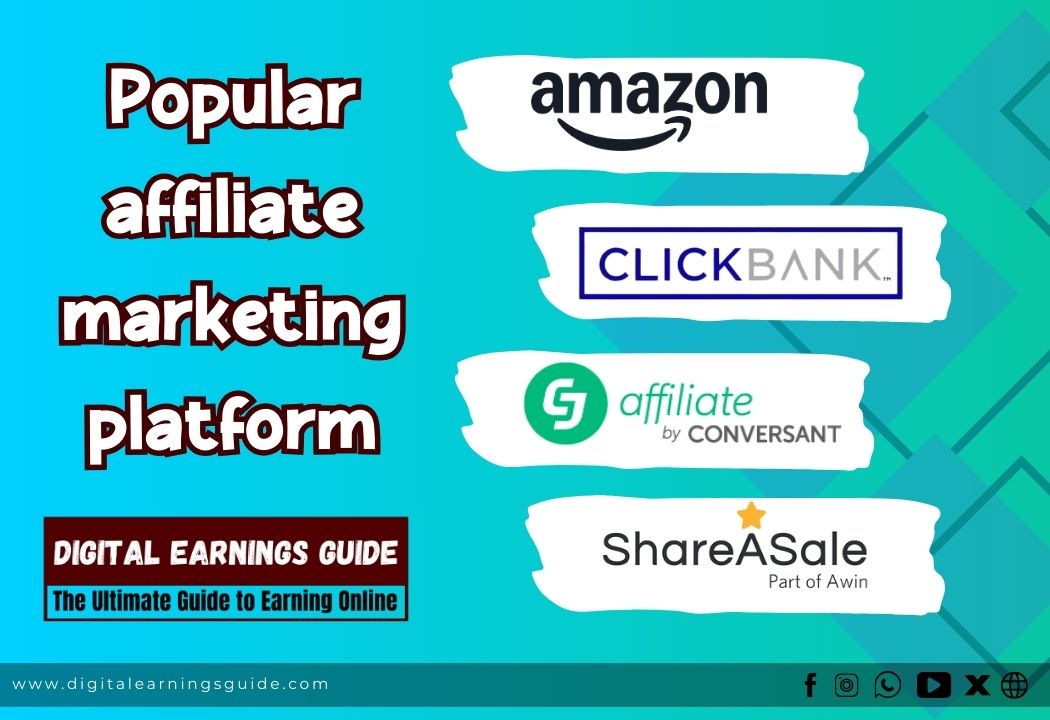What is Affiliate Marketing
Affiliate Marketing is a marketing strategy in which companies engage others, commonly called “affiliates” or “partners,” to promote their products or services. In this system, the affiliate is paid a certain commission when he persuades a customer to buy the company’s products or services. In this way, companies can work in a wider scope to promote their business and reach customers.

What we discuss in this article
| · Introduction to Affiliate Marketing
· Affiliate marketing works like a charm. · Popular Affiliate Marketing Models |
Important elements of Affiliate Marketing

Company (Merchant or Advertiser):
The company or business whose products or services are being promoted. This company provides a commission to the affiliate in return for the sale of its products.
Affiliate or Publisher:
These are individuals or companies that promote the company’s products or services through their websites, blogs, social media, or other platforms.
Customer:
A person who purchases a company’s products or services through an affiliate. The job of the affiliate is to convince the customer about the product and encourage him to buy it.
Affiliate Link:
The affiliate is provided with a unique link through which he directs the customer to the company’s website. When someone clicks on this link and makes a purchase, that purchase is counted as an affiliate sale.
Commission:
The Commission is money paid to an affiliate in exchange for a successful purchase or other action (such as signing up on a website). Its rates may vary and are determined by company.
Benefits of affiliate marketing
-
Low investment:
- Affiliates do not need much capital to start their business. They can only promote the company’s products using their website or social media platform.
-
Performance Based Earnings:
- Affiliates are paid only when they make sales or meet a set goal for the company, saving the company from unnecessary expenses.
-
Wider Access:
- Affiliate marketing allows companies to promote their products on different platforms, which increases their reach.
-
Time saving:
- Companies can save time by hiring affiliates instead of running their own marketing campaigns.
Challenges of Affiliate Marketing
-
Competition:
- There is a lot of competition in affiliate marketing, as many affiliates promote the same products or services.
-
Commission Rate:
- Some affiliate programs have very low commission rates, forcing affiliates to make a large number of sales in order to earn more.
-
Quality Control:
- Sometimes affiliates promote products using substandard or inappropriate content, which can affect the company’s reputation.
Affiliate Marketing Methodology
Affiliate marketing has a simple process:
- An affiliate joins a company’s affiliate program.
- The Company provides a unique link or code to the Affiliate.
- The affiliate shares this link on their website, blog, or social media.
- When a customer makes a purchase through this link, the company pays the affiliate a commission.
Popular Affiliate Marketing platform
Some of the popular affiliate marketing networks and platforms through which individuals can participate are:
Amazon Associates:
Amazon’s program through which you can promote their products.
ClickBank:
A digital products platform where affiliates can sell digital products.
ShareASale:
A large affiliate network that allows various companies and products to be promoted.
Commission Junction (CJ):
This is another large network that provides opportunities to promote products of well-known companies worldwide.
Affiliate Marketing is a business model in which companies use affiliates to promote their products or services. Affiliates promote the company’s products or services through their website, blog, social media platform or otherwise, and when a user makes a purchase through them or completes a certain action (such as signing up or completing a form), then the affiliate gets a commission in return.
The basic methodology of affiliate marketing
Affiliate program offered by the company (Merchant): First, any company that wants to increase the sales of its products or services starts an affiliate program. The program can also be run through a platform or be available directly on the company’s website.
Affiliates joining the program:
Individuals or companies who want to work as affiliates join these programs. When an affiliate joins the program, he is given a unique affiliate link that specifically identifies the affiliate.
Affiliate Link Promotion:
Affiliates promote this link through their platforms (website, blog, social media, YouTube, etc.). This link contains a unique tracking code that indicates that the user came from the affiliate’s website or link.
Purchase of user products or services:
When a user clicks on a link provided by an affiliate, he or she is taken to the company’s website. If he makes a purchase there or completes another specific action (such as signing up), that action is tracked.
Commission Calculation:
After a successful purchase or action is completed, the affiliate’s performance is tracked, and he/she receives a fixed commission. This commission can be either a fixed amount or a percentage of the total sale price.
Commission Payment:
Commission payment is usually made at the end of the month or may vary as per the terms of the company. Payment is usually made by bank transfer, PayPal or other payment methods.
Different types of Affiliate Marketing

Pay Per Sale:
In this model, the affiliate gets commission only when the user buys the product through his link. This is usually the most profitable model.
Pay Per Action:
In this model, the affiliate is paid a commission after a specific user action (like signing up, filling an email form, etc.). This model is mostly used in service based business.
Pay Per Click:
In this model, the affiliate is paid when the user clicks on the link provided by him, whether he makes a purchase or not. This model lowers the commission rate, but doesn’t necessarily lead to sales.
Key success factors of Affiliate Marketing
Choosing the right platform:
The affiliate should choose a platform that is suitable for his market. For example, if an affiliate is promoting fashion-related products, social media platforms such as Instagram or Pinterest may be more effective.
Creating Content:
Affiliates need to create content that impresses customers and entices them to make a purchase. This content can be in the form of blog posts, videos, product reviews, or guides.
Traffic Growth:
An affiliate’s success depends on how many people he can drive to his link. More traffic means more sales opportunities. Traffic can be increased through SEO (Search Engine Optimization), social media marketing, and paid advertising.
Choosing the Right Affiliate Program:
The affiliate should choose the programs that suit his interest and content. It is more profitable to promote products that affiliates are interested in and that are in demand in the market.
Benefits of affiliate marketing
Low Capital Requirement:
Affiliate marketing does not require a lot of capital to start. An affiliate only needs an internet connection and some platform where he can promote his links.
Performance Based Payment:
The affiliate is paid only when he achieves a successful sale or the desired action, making it a performance based model.
Flexible Work:
Affiliates can work as they wish and create and promote content according to their own timeline.
Challenges of Affiliate Marketing
High Competition:
Competition in affiliate marketing can be very high as there are many people trying to promote the same products or services.
No Guaranteed Results:
Affiliates don’t see immediate results for their hard work, and sometimes sales don’t come through despite their best efforts.
Commission rates:
Many affiliate programs have low commission rates, which require affiliates to generate more sales or clicks to earn a decent income.
There are several different Affiliate Marketing models tailored to business needs and affiliate strategies. Each model has a specific way of paying commission, and it depends on the action taken by the affiliate. Here is a breakdown of popular affiliate marketing models:
-
Pay Per Sale
The pay-per-sale model is the most common and profitable affiliate marketing model. In this model, affiliates receive a commission only when they persuade a customer to make a sale, that is, when the customer buys the company’s product through the link they provide.
Key Features:
- Commission Calculation:
- A certain percentage of the total sale price.
- Example:
- Amazon Associates Program, where affiliates promote Amazon products and receive a commission when someone makes a purchase through their link.
- Advantages:
- The business gets guaranteed sales.
- Affiliates get more lucrative commissions.
- Disadvantages:
- Affiliates have to work hard to sell.
- In the absence of sales, there is no revenue.
-
Pay Per Click (Pay Per Click)
In the pay-per-click (PPC) model, affiliates are paid a commission when a user clicks on their affiliate link, whether or not the user makes a purchase. This model is mostly used in online advertising.
Key Features:
- Commission Calculation:
- Commission is paid at a fixed rate per click.
- Example:
- Google AdSense, where website owners display Google ads on their website and earn money for each click.
- Advantages:
- Earnings potential without a sales requirement.
- Suitable for high traffic affiliates.
- Disadvantages:
- The commission per click is relatively low.
- Sometimes users click but it doesn’t produce any results, which doesn’t benefit the business.
-
Pay Per Lead
In a pay-per-lead model, an affiliate receives a commission when a customer completes a specific action, such as filling out a form, signing up to an email list, or taking a trial of a service. This model is mostly used by service-based businesses that are working to collect leads.
Key Features:
- Commission Calculation:
- A fixed rate commission is paid on each lead.
- Example:
- Financial institutions or insurance companies when affiliates are tasked with bringing information forms or sign-ups for new clients.
- Advantages:
- No sales required, just leads.
- Sometimes collecting leads is easier than selling.
- Disadvantages:
- Sometimes the leads are substandard or unsuitable, which can prove useless for the business.
- The commission rate may be low, especially if the leads are not verified.
-
Pay Per Install
Pay-per-install model is mostly used by mobile apps and software related companies. In this model affiliates are paid a commission when a user installs an application or software through their link.
Key Features:
- Commission Calculation:
- Every install earns commission at a fixed rate.
- Example:
- Mobile app developers or software companies use affiliates to increase installs of their applications.
- Advantages:
- Direct payment on every install.
- Installing is sometimes easier than selling.
- Disadvantages:
- The quality of installs can vary, and sometimes these installs don’t give the company the expected results.
- Users should not use the application after installation.
-
Pay Per Action
Pay-per-action (PPA) is a widespread model in which affiliates are paid when a user completes a specific action. This action can be anything, such as signing up for a product, attending a webinar, or subscribing to a service.
Key Features:
- Commission Calculation:
- Fixed commission based on specific process.
- Example:
- Affiliates are paid a commission for bringing in registrations for educational courses or subscriptions to a service.
- Advantages:
- Different commission opportunities on each different action.
- Businesses get specific results.
- Disadvantages:
- The commission rate on each action may vary, and sometimes these rates are very low.
- Certain actions such as subscription or registration may prove difficult.
-
Pay Per View (Pay Per View)
In the Pay Per View (PPV) model, affiliates are paid a commission when the ad or video they provide is viewed. This model is mostly used on video and advertising platforms.
Key Features:
- Commission Calculation:
- Fixed rate per view.
- Example:
- Ads for videos on YouTube, where earnings are based on the number of views.
- Advantages:
- Commission paid on every view.
- Greater earning potential with larger viewership.
- Disadvantages:
- The commission rate per view can be very low.
- Converting views into sales can be difficult.






Trackbacks/Pingbacks